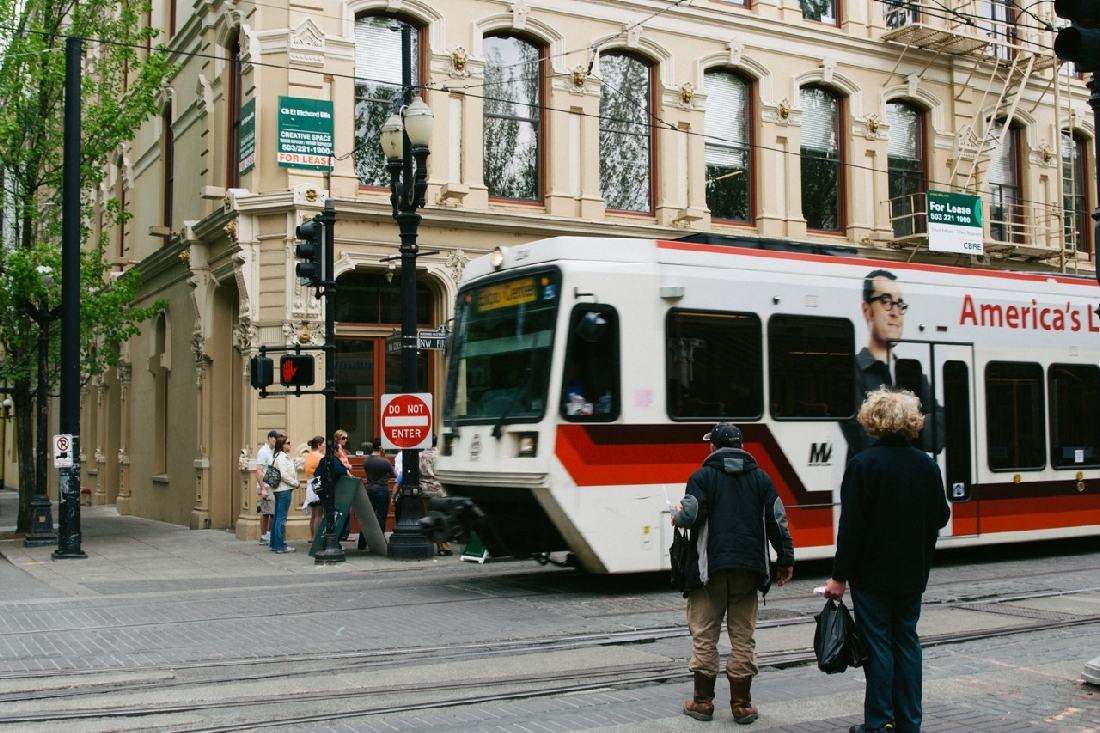Something one hears a lot as an advocate for a more walkable, bikeable, connected, and livable city is that Fort Worth isn’t Portland/Amsterdam/New York/Chicago/San Francisco/(insert any other more walkable/bikeable/transit-connected city here). Whatever you’re proposing –– transit improvements, better bike infrastructure, pedestrian facilities, or countless other examples you might care to use –– aren’t appropriate for Fort Worth, even though they’ve been successfully implemented in other cities. The implication is that our town, as a city of the Sun Belt, is genetically opposed to any sort of smart redesign to make it into the sort of place that city advocates speak out for.
The problem with that statement is that no city is inherently anything, except the result of countless decisions made over time to shape them in one fashion or another. Portland wasn’t always “Portland,” Amsterdam wasn’t always “Amsterdam,” and were it not for people like Jane Jacobs stopping Robert Moses, New York might not be the “New York” we know today. New Yorkers stopped freeway expansions that would have wiped out neighborhoods and sliced into the heart of Manhattan. Portland residents stopped one freeway from doing the same to them and used that money instead to start a better transit system, then removed another freeway for a waterfront park. Before it was the bicycling paradise of today, Amsterdam’s streets were becoming just as controlled by automobiles as any other modern city.
Even Dallas and Fort Worth were once much more dense and walkable than they are today, before the highways rammed through houses and neighborhood streets became speeding thoroughfares, and friendly sidewalks and storefronts were replaced by parking lots and drive-throughs. Through a series of public policy decisions that shaped private investment, our cities became places where car traffic was prioritized over foot traffic. We truly can undo the damage and re-balance our city so that it works for everybody.
Fort Worth can become whatever we want it to be, if we advocate for it and effect the change we want to see. There is nothing inherently “Portland” about a better transit system, nor is there anything inherently “Amsterdam” about making our streets safe for multiple forms of mobility. The sorts of things I write about in this series are pieces of a toolkit, not things unique to other places that we’re trying to shoehorn into Fort Worth. Building light rail or safer and more appealing bike lanes won’t remove any unique “Fort Worthiness” from our city; rather, it will make that Fort Worthiness more appealing by making the city more accommodating. We can adapt ideas like these from other places to make them work for Fort Worth –– to throw them out because “Fort Worth isn’t” a place is to prevent the city from ever growing and changing and improving.













Well spoken.
Perhaps the worst of those “countless decisions” made by FW council in 2006 was allowing heavy industrial in all zoning classes. FRacking put us light years behind other cities in the livability department. They have been trying to cover up that shit ever since the price dropped. The so-called FW Way, that vague notion of civic pride broadcast by a man behind the curtain named Moncrief, is responsible for much of the mess that we have. So, future planners have to work around that handicap. Good luck with that. Great piece, Kevin.
It’s extremely amusing to see someone who has no knowledge of developing a sustainable city (you just scratch the surface) compose an article critiquing an area on the lack of actually becoming legitimately more livable.
Most of the areas that are livable, are mostly like that because of the lack of land to develop on therefore increasing density which forces a city to view other transportional options. Amsterdam is getting worst to the point where the city is encouraging construction over bodies of water, this isn’t progressive, this is merely a city having to adapt to not being able to build on any available land.
Until Fort Worth’s urban sprawl/suburban sprawl packs the city límits, and there isn’t any land for developments at all, this is the stage where density throughout a whole city drastically increases. Once the inner city, and multiple areas around the inner core start inceasing in density, the city will be forced to change its infastrcuture. The down side is that the city has a lot of room to expand (and the city is still able to annex more land).
The way downtown is getting transformed, although it may not seem like a leap in the author’s eyes, will be a push in getting Fort Worth to head towards a more sustainable / livable path without needing to wait for the city to use up all of it’s available land. Just for the record, the Sun Belt doesn’t “not like” a smart design for the city, it’s just that we aren’t geographically limited to as other ancient cities that have had more time to develop. The Sun Belt is predominantly flat and landlocked therefore this is a perfect condition for urban sprawl to be almost never ending.
Anyways, point being Fort Worth’s early look onto becoming more livable is actually needed for the city to head into the right direction, other young cities don’t even have any movements to become livable.
These cities follow the path of allowing urban sprawl to max out, then they’ll realize that the city will have to be designed in a more intelligent manner.
While cities such as Fort Worth are looking into the problem at an early phase in the city’s development (Again, other cities don’t even think about planning out areas until they encounter problems).
Note: The Sun Belt is a whole new ballgame to developing livable cities since the geography is different, compared to other cit is most of our cities are “new”, and people are moving here by droves causing developments to outpace planning throughout a city.
This isn’t the same as livable areas located beside shores, and rough like terrain. (Such as Portland, New York, Ámsterdam)
The Sun Belt needs to find a new formula for developing cities with almost no geographical limitations, exponential population growth, etc.
It’s extremely amusing to see someone who has no knowledge of developing a sustainable city (you just scratch the surface) compose an article critiquing an area on the lack of actually becoming legitimately more livable.
Most of the areas that are livable, are mostly like that because of the lack of land to develop on therefore increasing density which forces a city to view other transportional options. Amsterdam is getting worst to the point where the city is encouraging construction over bodies of water, this isn’t progressive, this is merely a city having to adapt to not being able to build on any available land.
Until Fort Worth’s urban sprawl/suburban sprawl packs the city límits, and there isn’t any land for developments at all, this is the stage where density throughout a whole city drastically increases. Once the inner city, and multiple areas around the inner core start inceasing in density, the city will be forced to change its infastrcuture. The down side is that the city has a lot of room to expand (and the city is still able to annex more land).
The way downtown is getting transformed, although it may not seem like a leap in the author’s eyes, will be a push in getting Fort Worth to head towards a more sustainable / livable path without needing to wait for the city to use up all of it’s available land. Just for the record, the Sun Belt doesn’t “not like” a smart design for the city, it’s just that we aren’t geographically limited to as other ancient cities that have had more time to develop. The Sun Belt is predominantly flat and landlocked therefore this is a perfect condition for urban sprawl to be almost never ending.
Anyways, point being Fort Worth’s early look onto becoming more livable is actually needed for the city to head into the right direction, other young cities don’t even have any movements to become livable.
These cities follow the path of allowing urban sprawl to max out, then they’ll realize that the city will have to be designed in a more intelligent manner.
While cities such as Fort Worth are looking into the problem at an early phase in the city’s development (Again, other cities don’t even think about planning out areas until they encounter problems).
Note: The Sun Belt is a whole new ballgame to developing livable cities since the geography is different, compared to other cit is most of our cities are “new”, and people are moving here by droves causing developments to outpace planning throughout a city.
This isn’t the same as livable areas located beside shores, and rough like terrain. (Such as Portland, New York, Ámsterdam)
The Sun Belt needs to find a new formula for developing cities with almost no geographical limitations, exponential population growth, etc.
It’s extremely amusing to see someone who has no knowledge of developing a sustainable city (you just scratch the surface) compose an article critiquing an area on the lack of actually becoming legitimately more livable.
Most of the areas that are livable, are mostly like that because of the lack of land to develop on therefore increasing density which forces a city to view other transportional options. Amsterdam is getting worst to the point where the city is encouraging construction over bodies of water, this isn’t progressive, this is merely a city having to adapt to not being able to build on any available land.
Until Fort Worth’s urban sprawl/suburban sprawl packs the city límits, and there isn’t any land for developments at all, this is the stage where density throughout a whole city drastically increases. Once the inner city, and multiple areas around the inner core start inceasing in density, the city will be forced to change its infastrcuture. The down side is that the city has a lot of room to expand (and the city is still able to annex more land).
The way downtown is getting transformed, although it may not seem like a leap in the author’s eyes, will be a push in getting Fort Worth to head towards a more sustainable / livable path without needing to wait for the city to use up all of it’s available land. Just for the record, the Sun Belt doesn’t “not like” a smart design for the city, it’s just that we aren’t geographically limited to as other ancient cities that have had more time to develop. The Sun Belt is predominantly flat and landlocked therefore this is a perfect condition for urban sprawl to be almost never ending.
Anyways, point being Fort Worth’s early look onto becoming more livable is actually needed for the city to head into the right direction, other young cities don’t even have any movements to become livable.
These cities follow the path of allowing urban sprawl to max out, then they’ll realize that the city will have to be designed in a more intelligent manner.
While cities such as Fort Worth are looking into the problem at an early phase in the city’s development (Again, other cities don’t even think about planning out areas until they encounter problems).
My mistake, the site said my rely didn’t get through, I thought it was the username.